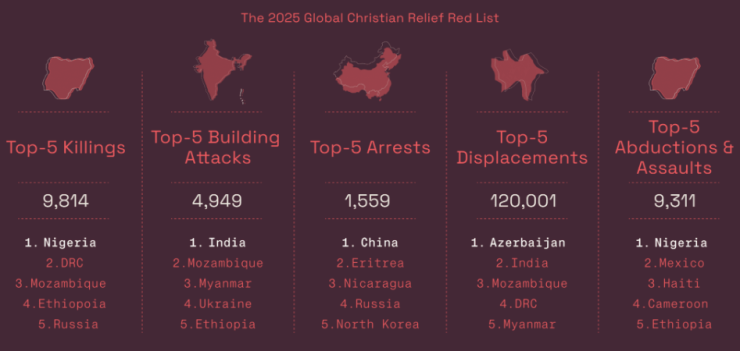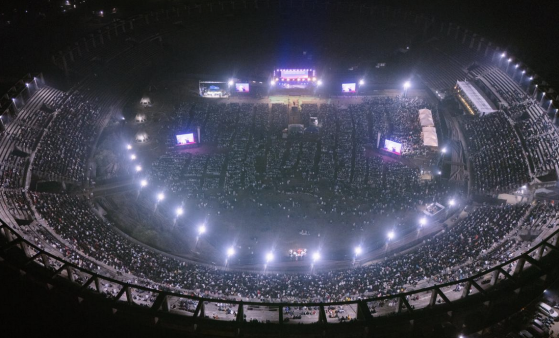
India has recorded the highest number of attacks on Christian properties globally, with 4,949 incidents targeting homes, businesses and places of worship between November 2022 and 2024, according to a new report by Global Christian Relief (GCR). This finding is corroborated by the International Christian Concern’s (ICC) 2025 Global Persecution Index, which places India in its “moderate persecution” category.
As per GCR findings, the violence against Christians peaked in Manipur state, where ethnic tensions erupted in May 2023 as Hindu extremists from the Meitei tribe systematically targeted predominantly Christian Kuki communities. A Kuki pastor from Imphal described the organised nature of attacks: “They knew exactly where I lived... and they arrived on trucks with flamethrowers and gas canisters to burn us out of our homes.”
The ICC report identifies three main groups driving persecution: the Bharatiya Janata Party (BJP), despite its reduced parliamentary majority after the 2024 elections; the Rashtriya Swayamsevak Sangh (RSS), a paramilitary organisation promoting Hindu supremacy; and radicalized Hindu mobs who often livestream their attacks, developing significant social media followings.
Key figures highlighted in the ICC report include Uttar Pradesh Chief Minister Yogi Adityanath, who publicly declared, “When I ask them to rise and protect our Hindu culture, they obey. If I ask for blood, they will give me blood.” Under his administration, the state’s anti-conversion ordinance has led to over 230 imprisonments since 2021.
The persecution pattern follows a broader trend seen in anti-Muslim violence, with large-scale riots now increasingly targeting Christian communities in states like Chhattisgarh and Manipur. Nearly half of India’s 28 states maintain anti-conversion laws, which the ICC notes are “so broadly phrased as to outlaw even the most basic practices of religious life.”
Prime Minister Narendra Modi’s leadership since 2014 has seen India take an increasingly nationalist direction. The ICC report criticises Modi for promoting radical figures like Adityanath and championing nationalist causes such as the Citizenship Amendment Act, which restricts religious minority rights.
The crisis has forced massive displacement, the ICC noted, with over 60,000 Christians compelled to flee their homes in Manipur alone, many now living in temporary camps. Despite thousands of legal cases under various anti-conversion laws, the ICC reports that no Christian has ever been convicted of forced conversion, highlighting the laws’ use as tools of intimidation.
The ICC report concludes that while the BJP’s reduced electoral mandate in 2024 may hamper its nationalist agenda due to more secular coalition partners, the systematic oppression of religious minorities continues to pose a significant threat to religious freedom in India.
While the ICC report highlights the political and social drivers of persecution, the GCR’s inaugural ‘2025 Red List’ report provides quantifiable data across five categories: killings, building attacks, arrests, displacements, and abductions and assaults. This data, compiled through GCR’s Violent Incidents Database in partnership with the International Institute for Religious Freedom, places India’s persecution within a broader regional context.
While India leads in attacks on Christian properties with 4,949 incidents, neighbouring Myanmar recorded 1,490 building attacks during the same period, highlighting the regional scope of anti-Christian violence.
Ukraine has seen the highest number of church-specific attacks globally, with 1,270 recorded incidents, primarily from Russian artillery strikes. However, India’s pattern of persecution stands distinct, as it encompasses systematic targeting of both religious buildings and private Christian homes, particularly evident in states like Manipur and Chhattisgarh.
The Red List data, drawn from GCR’s Violent Incidents Database launched in January 2024, demonstrates that persecution in India has evolved into a complex web of social, political, and institutional discrimination. Brian Orme, GCR’s acting chief executive, notes that despite these challenges, Christian communities show remarkable resilience. “Even in the darkest circumstances, the Church not only survives but grows stronger. Millions are choosing to follow Jesus despite knowing the risks they face,” he stated in the report.
The persecution in India follows different patterns from other high-ranking countries on the Red List. While Nigeria leads in Christian deaths with 9,814 killings, and China tops arrests with 1,559 detentions, India’s persecution is marked by systematic destruction of property and forced displacement, suggesting a coordinated effort to dismantle Christian communities’ economic and social foundations.
Ethiopia, which ranks fifth on the GCR Red List for Building Attacks with 488 incidents, provides a stark comparison to India’s situation. While Ethiopian Christians face targeted attacks from Islamic militants primarily in specific regions, India’s persecution spans multiple states and involves various actors, from state authorities to mob violence.
Ron Boyd-MacMillan, GCR’s chief of research and global strategy, led the compilation of the Red List alongside a team of persecution experts, scientists, and researchers. Their findings suggest that India’s anti-Christian violence represents a unique challenge due to its multi-faceted nature, combining grassroots violence with institutional discrimination and political marginalisation.
The report indicates that compared to countries like Azerbaijan, where 120,001 Christians were displaced in a single event, India’s displacement of 60,000 Christians represents a more gradual but equally destructive pattern of persecution. The displacement in India, particularly in Manipur, has created a humanitarian crisis with thousands living in temporary camps, their homes and livelihoods destroyed.




